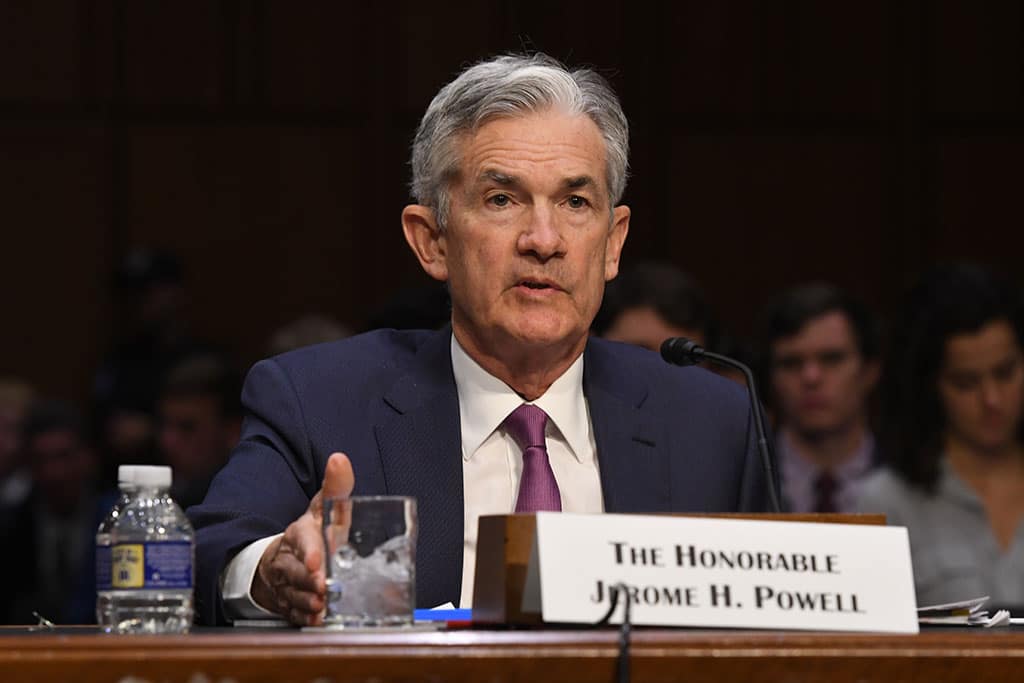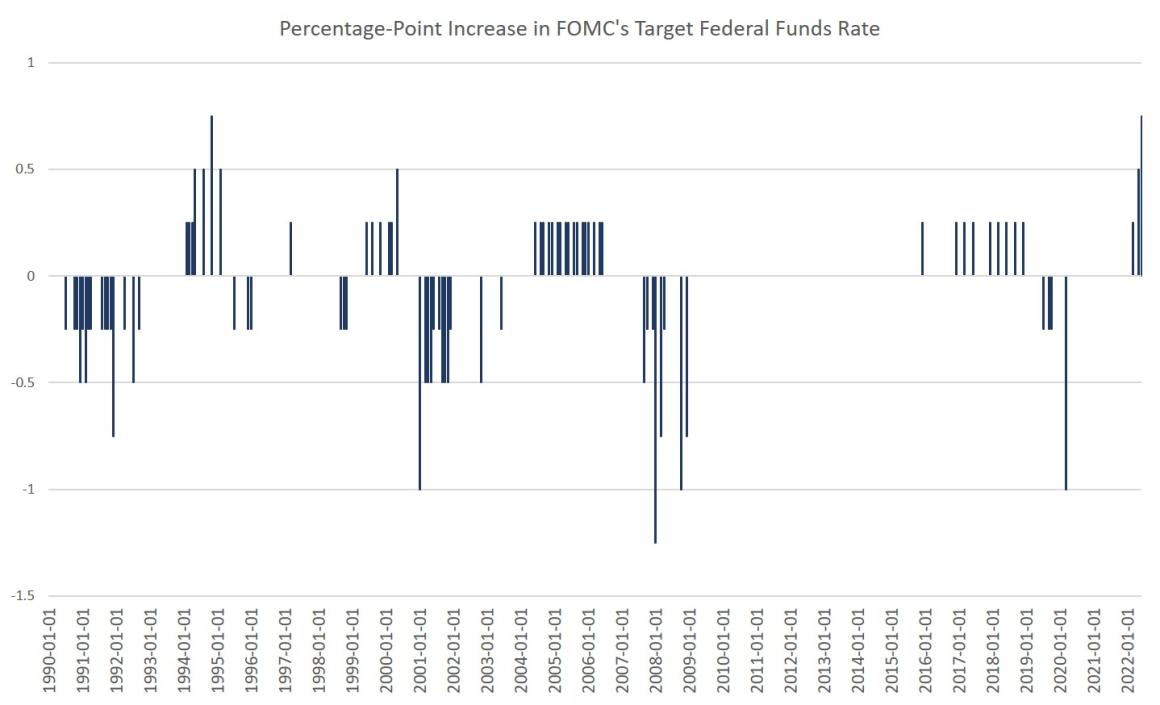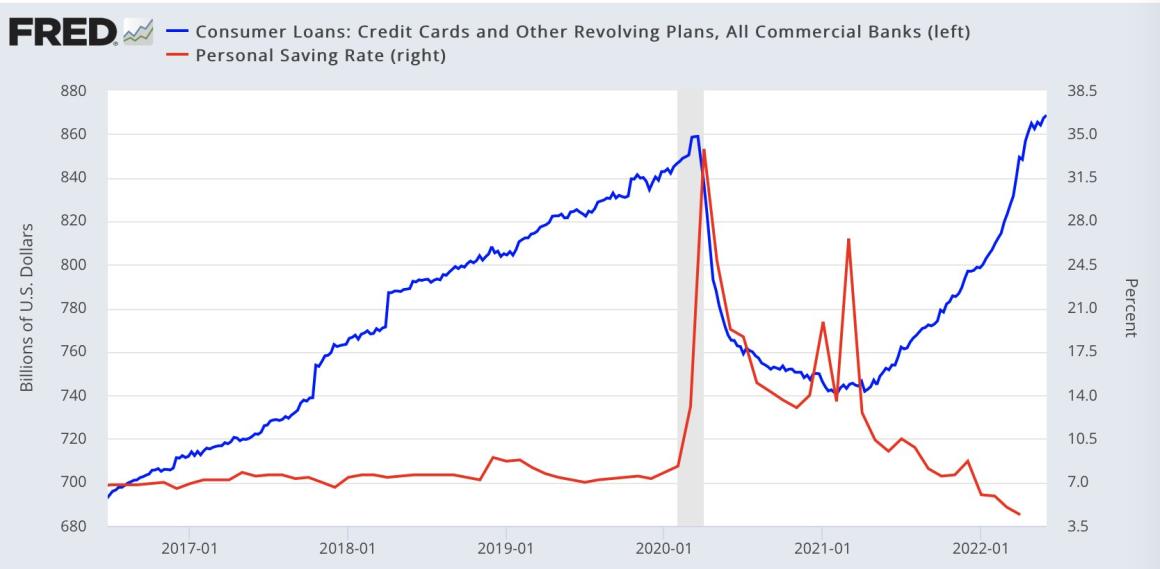The Federal Reserve’s Federal Open Market Committee (FOMC) today announced an increase of 75 basis points to the target federal funds rate, raising the rate to 1.75% from 1%. June’s meeting today was the third meeting this year at which the FOMC has raised rates. Coming into the March meeting this year, however, the FOMC had not raised the target rate since March of 2020, even though price inflation began to accelerate during the second half of 2021.
Today’s 75-basis-point increase is the largest increase since late 1994 when the FOMC raised the target rate from 4.75% to 5.5%.
Notably, however, this increase comes mere weeks after the Fed Chair Powell slapped down the idea of a 75-basis point increase in June. As reported by Reuters on May 4, Powell had insisted “A 75 basis point increase is not something that the committee is actively considering.”
That didn’t last long.
The fact that the Fed was forced to hike the target rate by higher than it had suggested was even possible earlier in the year is a reminder that the Fed and its economists are simply in a reactionary mode when it comes to the US economy’s problem with mounting price inflation.
As even Powell admitted during today’s press conference, the Fed was surprised by how high price inflation has grown. The Fed then had to pivot in order to answer calls that the central bank “do something” about price inflation.
But when it comes to the Fed’s decisions about setting target rates, it is I increasingly obvious there is no model. The “plan,” to the extent one exists at all, amounts to “let’s see how bad inflation is, and then we’ll pick a target rate and hope that solves the problem.”
How Fed Is Framing Its Response to High Inflation
One should never expect a frank assessment of economic conditions from the Fed. It will always lean toward boosterism rather than accuracy or honesty. But conditions have apparently worsened to such a degree that even the Fed was forced to take a more pessimistic view in its new statement—compared to last month. Specifically, the Fed did not repeat an assessment from last month that household spending and investment “remained strong.” Moreover, the FOMC’s release begins with a statement that economic activity “appears” to have improved since the first quarter:
Overall economic activity appears to have picked up after edging down in the first quarter. Job gains have been robust in recent months, and the unemployment rate has remained low.
Note that the Fed continues to cling to jobs data as its primary evidence that the economy is robust. This, however, comes in spite of the fact that GDP growth was negative during the first quarter of this year, and the Atlanta Fed now predicts GDP will grow 0% in the second quarter. Apparently, at Powell’s Fed, an economy with negative-to-zero growth is a “strong” economy. Moreover, numerous indicators point to recession. The yield curve is flattening, retails sales are down, the S&P500 is in bear territory, and home sales are falling off as mortgage rates rise. Consumer credit is rising to historic highs as the saving rate collapses. But at the Fed, they showcase an economic indicator that trails most others: employment. In other words, the Fed is keeping its eye fixed on the rear view mirror in order to sing the praises of the Biden economy.
The Fed’s release then goes on to blame the pandemic, Russia, and China for price inflation. Needless to say, there is no mention of massive monetary inflation created by the Fed over the past decade.
After last week’s announcement of inflation rising near a 41-year high—with year-over-year growth at 8.6 percent—the Fed nonetheless clearly believed it had to do something. That “something” was raising the target rate by 75 basis points rather than the 50 basis points that Powell had long insisted would be sufficient.
But why 75? When asked during the press conference to quantify how 75 basis points is better than 50, Powell had no answer beyond saying the committee simply decided to speed up the time frame of rate increases. The standard employed for coming to this conclusion, according to Powell himself, came down to “75 [basis points] seemed like the right thing at this meeting.” Needless to say, this didn’t answer the question of what we are to expect from that additional 25 basis points.
Moreover, although many Fed watchers are now framing Fed policy as exceptionally hawkish, Powell himself stated that in his opinion, “right now our policy rate is well below neutral” and that a target rate of 1.75 is only “moderately restrictive.”
If a 40-year high in inflation calls for only moderately restrictive policy that remains below neutral, it’s difficult to imagine how much inflation will be necessary before the Fed regards truly restrictive policy as actually necessary.
On this last question, the Fed itself offers no real plan or guidance. According to the so-called “dot plot,” Fed members have suggested that the target rate may reach 3.8 percent next year. But will that be “enough” to truly rein in price inflation? When asked about this, Powell responded “we’ll know when we get there.”
Low Interest Rates Are Still Needed to Suppress Interest on the Debt
In practice, however, it is very unlikely the Fed will allow the target rate to rise much above 3.5 percent no matter what. With federal debt still exploding, allowing rates to double from today’s rate would drive up interest on Treasurys and place an enormous burden on federal budgets in terms of debt service. This would require very large budget cuts to popular programs. So far, its hard to believe the Fed will abandons its current de facto policy of supporting Federal deficit spending through suppressing interest rate growth.
The Fed also continues to take an ultra-safe approach when it comes to Wall Street and employment. Powell at today’s meeting explicitly claimed the Fed is still trying to avoid a recession. In other words, inflation is still preferable to recession. That suggests we should continue to expect inflation rates well in excess of the Fed’s arbitrary 2% target.
If the Fed continues as it’s going, we’ll need to get used to declining real wages and near-zero real growth for a while.
This article was originally featured at the Ludwig von Mises Institute and is republished with permission.


































